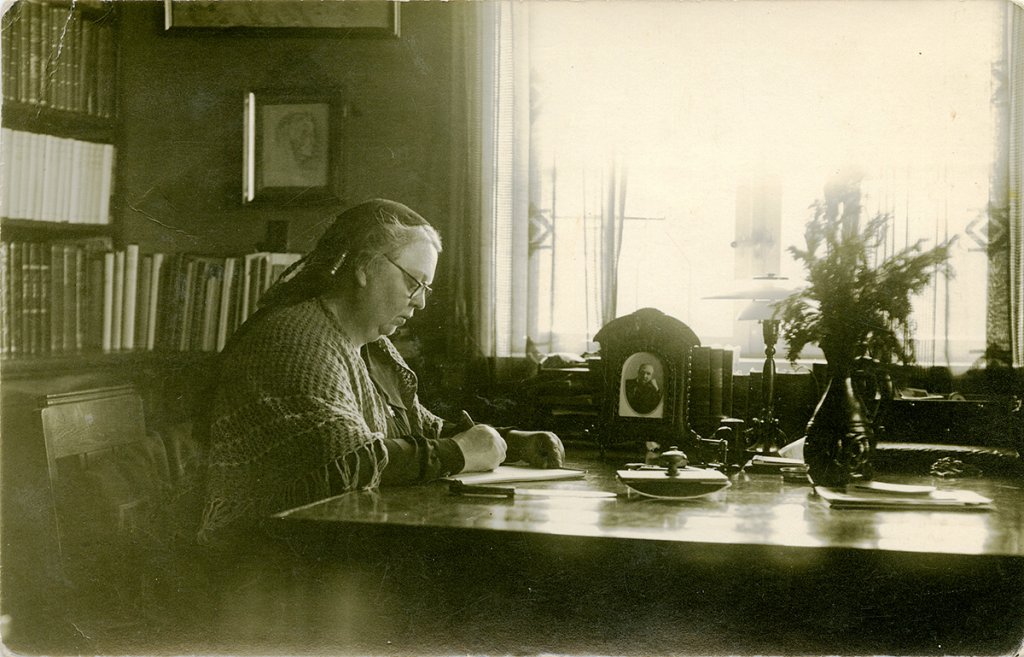
No products found for vendor
Sigrún Pálsdóttir Blöndal was born in Hallormsstaður, East Iceland in 1883. She grew up in a home where culture and the arts played a major role: Her father, Páll Vigfússon, had a degree in philosophy from the University of Copenhagen, and was the co-founder of the magazine "Austri". Her mother, Elísabet Sigurðardóttir, loved literature, history and genealogy. Páll returned from Denmark to work on the family farm. He was considered to be an excellent farmer, but died young in 1885.
Sigrún was a good student and moved to Reykjavík when she was 17. She enrolled at the Women's College (Kvennaskólinn), and finished the program within one year. In 1905, she participated in a summer program in Copenhagen, studying home economics and domestic arts. In 1911, she travelled to Denmark once more to study at the Folk High School in Askov, along with seven other Icelanders. Sigrún was very interested in domestic economy and weaving, in particular, and taught many workshops in South and East Iceland upon returning to Iceland.
In 1918, Sigrún married Benedikt Blöndal, a teacher at a district school in East Iceland, Eiðar. Sigrún and Benedikt were both interested in exploring different methods in teaching, and preferred giving lectures to the more traditional, book-centric approach. At Eiðar, Sigrún taught various subjects, including Danish, gardening, and weaving, and managed the school's summer programs at the school with her husband.
When Sigrún inherited the farm Mjóanes, the couple decided to leave Eiðar and moved to the shore of lake Lagarfljót in 1924. In the old farmhouse at Mjóanes, Sigrún and Benedikt founded a new school, which they managed for six years. The school accepted both boys and girls at first - many of them former students from Eiðar - but only girls later on.
Sigrún was very interested in starting a Women's School in East Iceland, the type of home economics school that already existed in other parts of the country. Both she and her husband played an important role in the foundation and management of the Women's School (Húsmæðraskólinn) in Hallormsstaðir in 1930, which is known as Hallormsstaðarskóli today. Sigrún directed the school from 1930 onwards. Benedikt also worked there as teacher, and was the main caretaker of the school building, stables, and animals.
In the following years, Sigrún taught, travelled, worked as a representative for the publisher Mál og Menningar, and presented lectures on Icelandic literature, e.g. at the annual meeting of the Icelandic Women's Association in 1943. One of Sigrún's close friends was Halldóra Bjarnadóttir, the editor of an annual Icelandic magazine Hlín. For Hlín, Sigrún wrote a book on weaving, which was included in the annual subscription from 1932 - 1944.
Sigrún and Benedikt had two two children, and also raised two foster children. Their son Sigurður, a forest specialist, studied in Norway and later returned to East Iceland, where he became the forest manager at Hallormsstaður. In 1939, Benedikt Blöndal died in an accident, only 56 years old. Sigrún died five years later, on November 26, 1944, due to a sudden illness.
Húsmæðraskólinn in Hallormsstað
The Women's School (Húsmæðraskólinn) in Hallormsstað, East Iceland, opened on November 1st, 1930. The school house was not entirely finished just yet. The school was divided into two departments, first and second year students. Every week, the head of school, Sigrún, presented two lectures on literature, and her husband and fellow teacher Benedikt two lectures on history and culture. School days started at 8 am, with a psalm being sung, and ended at 10 pm.
Before lunchtime, students would attend different practical courses, such as gardening, embroidery, weaving, and cooking, and have theory lessons. During the second part of the day, there was a coffee break and outdoor activities, as well as a one hour handicrafts session. The day ended with beforementioned lectures, dinner at 7 pm, and the singing of psalms at 10 pm.
Three times a week, a kvöldvaka ("evening wake") was held, where teachers would take turns reading for students. The kvöldvaka is a custom cultivated during the long, dark winters in Iceland. All members of a household would sit together in the room known as the baðstofa, the central room in the traditional Icelandic turf houses, where everyone lived, slept, and worked. People would spend the evening doing handicrafts, working the wool, or doing repairs while telling each other stories, reciting poetry, and reading from the scriptures. Sigrún wanted the school to be as welcoming and homely as possible for both teachers and students. Everyone shared the same house and responsibilities, and spend a lot of time together.
During the first three years, there were only around 15 - 20 students per year. These were difficult times in Iceland, and not many families could afford the tuition. From 1933 onwards, however, the school was fully booked, with up to 30 students attending every year. In 1943, a special weaving department was opened, a two year program, where only two girls were educated at a time. One of the students graduating this program was the Icelandic artist Guðrún Vigfúsdóttir.
Sources:
Eiríkur Sigurðsson. (1978). Af héraði og úr fjörðum. Reykjavík: Bókfell hf. [bls. 11 – 38]
Halldóra Bjarnadóttir. (1970). Sigrún P. Blöndal. Heima er bezt, bls. 69 – 72.
Sigurður Blöndal. (1979). Sigrún Pálsdóttir Blöndal. Í Gísli Kristjánsson (Ritstj.)Móðir mín húsfreyjan, 187 – 220. Reykjavík: Bókfell hf.
